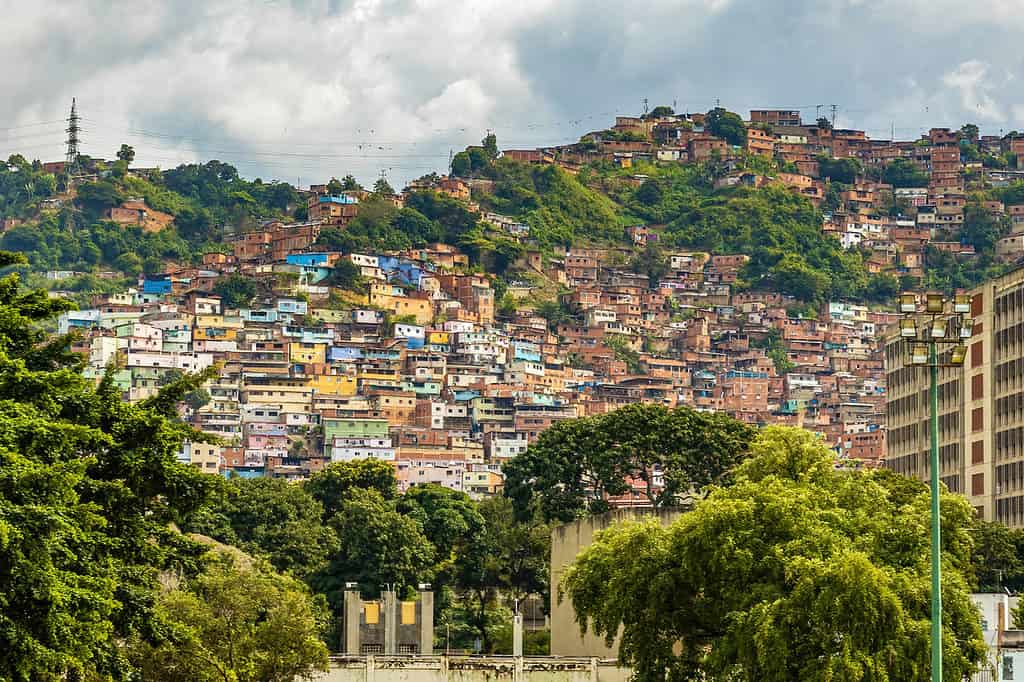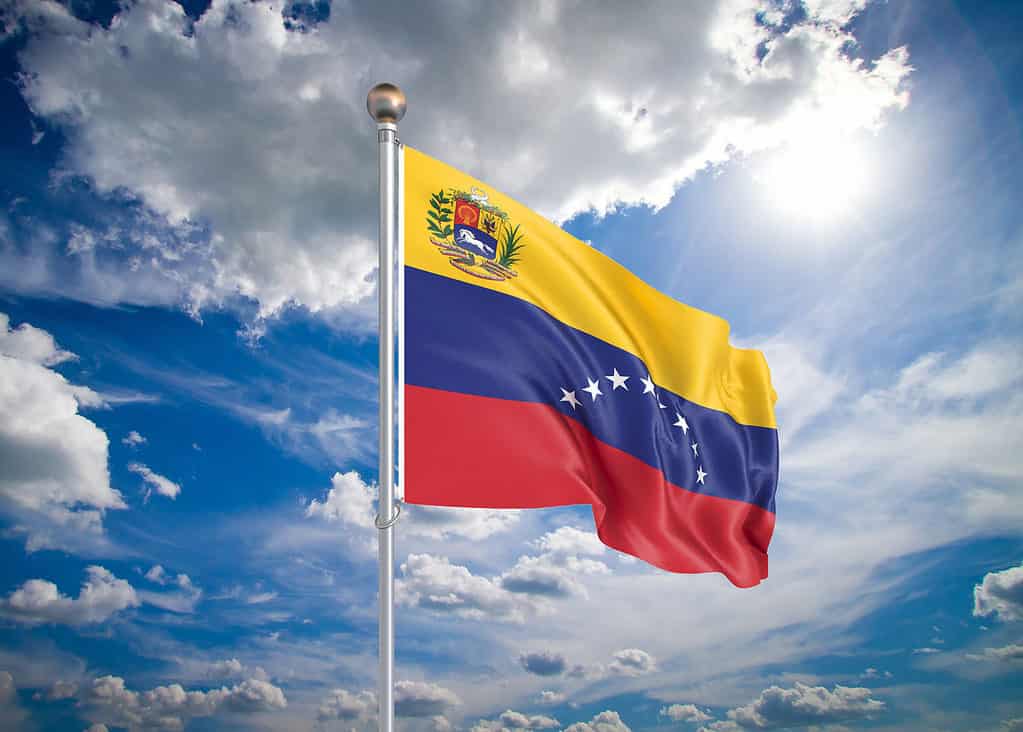Venezuela, officially called the Bolivarian Republic of Venezuela, is a country on the northern coast of South America. The country consists of many islands and shares borders with the Caribbean Sea and the Atlantic Ocean to the north. It also has shared borders with Trinidad and Tobago to the northeast, Guyana to the east, Colombia to the west, and Brazil to the south. Apart from its rich culture and diverse cuisine, Venezuela is popular with many other countries and tourists because of its natural beauty.
The nation is well-known for being home to some of the world’s most beautiful natural sights and even the highest waterfall ever recorded, Angel Falls. Venezuela is also the birthplace of Simon Bolivar, who helped several South American countries gain independence from Spanish rule.
Apart from being a top world tourist location, Venezuela is also known for its flag. Discover everything you need to know about the Venezuelan flag, including its history, meaning, and symbolism in this article.
Venezuela: Geography and Climate
As previously established, Venezuela is a nation in the northeastern region of South America. Its capital, Caracas, is also the country’s primary hub for industry, trade, education, and tourism. With its high mountains, lush rainforests, wide river plains, and coastal plains, the nation’s geography is extremely diverse, offering a variety of natural ecosystems. The highest point in the country is Pico Bolívar, which stands at an impressive height of 16,335 feet (4,979 m). Venezuela is also home to several table-top mountains also called tepuis or tepuys.
Venezuela’s climate is affected by two primary factors- its tropical nature and proximity to the equator. The country has an isothermal climate, meaning that temperatures are generally consistent throughout the year with little seasonal variance. However, another factor that affects the country’s climate to an extent is elevation.
Based primarily on elevation, the nation is divided into four horizontal temperature zones: tropical, dry, moderate with dry winters, and arctic climates. In the country’s tropical zone which is below 3,000 feet, the temperatures are usually hot, falling between 78.8 and 82.4 °F (26 and 28 °C). The temperatures in areas that are between 2,700 and 6,562 feet range between 53.6 to 77.0 °F (12 to 25 °C). On the other hand, the regions with colder temperatures between 48.2 to 51.8 °F (9 to 11 °C) are in areas between 6,562 and 9,843 feet.
Venezuela: Culture and Cuisine

Venezuela is the world’s 33rd largest country by land area.
©iStock.com/GummyBone
With an estimated population of around 29 million people, Venezuela has a total area of 916,445 kilometers square (353,841 square miles) and a land area of 882,050 kilometers square (340,560 square miles). The country is currently the world’s 33rd largest country by land area. The nation is commonly referred to as a country of immigrants, with people from different parts of the world combined in one space to make a huge melting pot of cultures.
Despite having a mix of almost every culture in the country, three primary cultural groups have the most population and the longest ancestral ties to the country- the Indigenous Venezuelans, the Africans, and the Spanish. The present-day culture of the country was obtained through cultural syncretism; a combination of different beliefs and practices. Each culture had an impact on the overall development of Venezuelan culture. Indigenous Venezuelans and Africans impacted food, the names of places, and the use of certain words. Africans also affected music in the country, particularly with the introduction of drums. However, the culture with the most impact is Spanish, seeing as they ruled the country before its independence. Spanish influence can be seen in aspects such as language, music, and religion.
Another area of Venezuelan culture that was affected by the Spanish and some of the other prevalent cultures that formed what is now known as Venezuelan culture is the cuisine. Generally, Venezuelan cuisine draws inspiration from its West African and European traditions, especially Italian, French, and Spanish. However, despite the general influence these other traditions have on Venezuelan cuisine, the country’s different regions each have their distinct way of cooking. Also, the popular dishes in each region differ. There are also several ingredients that are recurring in many popular Venezuelan dishes, such as corn, which has long been harvested in the country, and white cheese.
Venezuela: Language and Religion
Since Venezuela is a country that was formed by the combination of many different cultures, it is no surprise that there are different languages spoken throughout the country. Its constitution regards the presence and use of over 30 languages that vary from region to region. The primary reason for the presence of several languages in the country is the retention of the original languages of the immigrants. For instance, Chinese, Italian, and Portuguese are the most spoken foreign languages in the country.
Because of their colonization, one of the official languages of the country is Spanish. Venezuelan Spanish is different from the Spanish spoken in other Latin American countries. However, this difference is not staggering enough to cause a language barrier; it can primarily be noticed in colloquial phrases and verb usage. Other popular languages in the country include Arabic, which is spoken by Lebanese and Syrian colonies in several parts of the country, and German. Because international firms have been exploring oil in Venezuela, in addition to its popularity as a lingua franca, English is also a widely used language by many professionals, professors, and members of the upper and middle classes. Immigrants from Trinidad and other British West Indies countries brought English to Venezuela.
The Venezuelan constitution also recognizes the use of several indigenous languages, although they are not spoken by many people. The most popular indigenous language spoken in Venezuela is Wayuu, with an estimated 170,000 speakers.
The constitution of Venezuela also recognizes and provides for religious diversity. However, almost everyone in Venezuela is Christian, with a large percentage of these people practicing Roman Catholicism. The rest of the Christian population is divided into Protestants and Evangelists. Other religions practiced in the country include Judaism, Buddhism, and Islam. The Muslim community mostly consists of persons of Lebanese and Syrian descent living in a region of the country. On the other hand, the majority of the Buddhist community consists of Chinese, Japanese, and Korean individuals.
Despite the practice of several religions in the country, a small percentage of the country’s inhabitants are irreligious, either as atheists or just indifferent.
History of the Flag of Venezuela

The flag of Venezuela was adopted in 2006.
©iStock.com/Vector
The current Venezuelan flag was introduced in 2006, with the inclusion of the eight stars, but the original tricolor flag dates back to 1811 during the independence war. Before the official addition of the stars, this flag had undergone several modifications, including the addition of the coat of arms in the upper left corner. However, all variations of this flag can trace their history to the flag of Francisco de Miranda, who was one of the initial revolutionary leaders in the countries/regions that made up Spanish America. His flag was an inspiration for the development of the flag of Venezuela and the flags of some other countries that bear close resemblance with the flag of Venezuela.
The original flag of Miranda is believed to have been obtained in two ways. The first was a conversation he had with a German friend, who explained the concept of primary colors to him and told him it was his job to introduce said colors to Spanish America. The second tale is that the hues were motivated by a military battalion the artist saw in Hamburg while he was there. However, whichever story one chooses to believe, the colors had been picked out by Miranda in 1801, long before its original use. Venezuela added stars to its flag to symbolize the country’s regions, and during the course of its history, the constellations of those stars have changed multiple times. The most recent alteration took place in 2006 when Venezuela switched out a circle of stars for the arch of stars that can be seen in the present design.
Flag of Venezuela: Meaning and Symbolism

The yellow color on the Venezuelan flag represents the nation’s prosperity.
©iStock.com/Primada
The flag of Venezuela is a simple design of three horizontal yellow, blue, and red colors, with eight stars at the center of the blue stripe. Different people have different interpretations of the flag’s colors, but the most widely recognized one is that the yellow color stands for the nation’s prosperity, the wealth of Venezuelan land, gold, sovereignty, peace, justice, and farming, as well as the Sun, which is the primary light source. The blue is believed to represent the Caribbean Sea that surrounds the country and its other beaches. The red signifies the blood shed by the people of Venezuela during their fight for independence from Spain. The eight stars are a representation of the provinces that make up the country.
Up Next:
Every Flag In The World: Photos, History, and More
26 Countries With Tricolor (Triband) Flags
The photo featured at the top of this post is © iStock.com/-Panya-
Thank you for reading! Have some feedback for us? Contact the AZ Animals editorial team.







